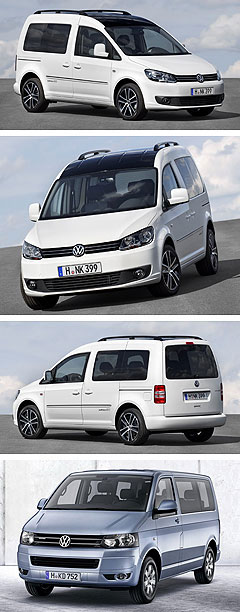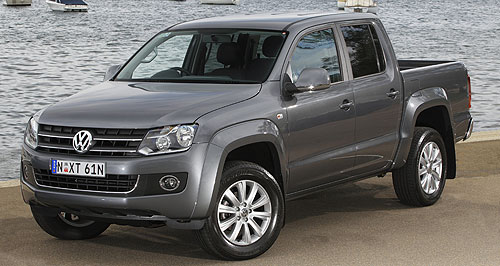Make / Model Search
Future models - Volkswagen - Amarok - automaticFrankfurt show: VW Amarok with eight-speed autoSuper eight: Volkswagen Australia will introduce an eight-speed conventional automatic transmission to its Amarok range next year. Eight-speed auto for Australia’s VW Amarok next year – with 132kW ‘TDI420’ engine15 Sep 2011 By TERRY MARTIN VOLKSWAGEN Group Australia has confirmed the Amarok will again raise the bar in the one-tonne utility segment next year after the German auto giant announced at this week’s Frankfurt motor show that it is poised to introduce a new eight-speed automatic transmission for the vehicle. As GoAuto reported exclusively in February, the German auto giant has developed the new eight-speed torque-converter auto in conjunction with ZF, foregoing a dual-clutch automated-manual DSG unit commonly found across VW’s passenger-car lines after it was deemed unsuitable for low-speed carrying or hill-climbing work. At this stage, the self-shifter will be a flagship affair, combining only with the Amarok’s permanent four-wheel-drive system and a new range-topping engine: a 132kW/420Nm version of the current 2.0-litre four-cylinder twin-turbo diesel. This combination enables the Amarok to reach a top speed of 179km/h in seventh gear and hands it strong overtaking potential, with acceleration from 80 to 120km/h in a claimed 8.5 seconds. This is understood to be the same transmission used in the second-generation Touareg SUV launched in Australia in July, but in the big SUV it is paired with a single-turbo 3.0-litre V6 diesel and a 3.6-litre V6 petrol engine.  Left: Volkswagen Caddy 30 and Mulitvan BlueMotion. Left: Volkswagen Caddy 30 and Mulitvan BlueMotion.The ‘TDI400’ engine used in Australia’s current Amarok range produces 120kW at 4000rpm and 400Nm between 1500 and 2500rpm. A lower-output single-turbo TDI340 was also recently introduced, offering 90kW at 3850rpm and 340Nm from 2000rpm. In what is likely to be known as the ‘TDI420’ model, the eight-speed auto also combines in Europe with eco-oriented ‘BlueMotion Technology’ – including engine idle-stop, regenerative braking and low rolling-resistance tyres – to achieve combined-cycle fuel economy of 7.6 litres per 100km and CO2 emissions of 199g/km. This compares with 7.9L/100km and 209g/km for the lower-output TDI400 4x4 Amarok (both permanent and part-time 4WD) when mated with the standard six-speed ZF manual gearbox. The Amarok auto will reach European showrooms in January 2012, but Volkswagen Group Australia was this week unable to provide details on Australian launch timing or specification. It did, however, confirm that the model will be released here next year. At the Frankfurt show, Volkswagen said a number of benefits flowed from the auto’s additional gears, including more agility and lower consumption. The eighth gear is configured as a fuel-saving overdrive gear that operates at reduced engine speed, while first gear is short for more effectiveness in off-road situations and when towing. Significantly, maximum braked capacity for Amarok increases to 3200kg with the TDI420 auto, up from 2800kg with the TDI400 manual. The company claims that the low engine revs generated with the new gearbox reduce noise and therefore improve comfort. Enhanced torque converters with “optimised” vibration dampers are also used. As GoAuto has reported, Amarok is also due to receive a single-cab body variant and a 2.0-litre turbocharged petrol TSI engine next year. The Amarok brought a number of firsts to the one-tonne utility segment in Australia when it was launched in February, including a maximum five-star safety rating, electronic stability control, four airbags and sub-8.0L/100km fuel consumption across the range. VW also used this week’s Frankfurt show to exhibit a special Edition 30 ‘prototype’ version of its Caddy, marking the 30th anniversary of the compact van. Continuing the theme of the Multivan Edition 25 that was introduced in Australia in June, the Caddy 30 picks up a gloss-black roof and roof rails, black 17-inch machine-polished alloy wheels and high-end interior features, including Alcantara seat trim, a multi-function leather-clad steering wheel, tinted windows and semi-automatic climate-control air-conditioning. It also features a 125kW 2.0-litre TDI engine with DSG gearbox, making it the most powerful Caddy ever built by the German manufacturer. A BlueMotion version of the Multivan was also shown and stands as the most fuel-efficient Multivan ever, with technology such as idle-stop combining with an 84kW 2.0-litre TDI engine to achieve 6.4L/100km economy and 169g/km in CO2 emissions. This is 0.9L/100km and 24g/km less than the current 75kW standard model.  Read more1st of July 2011  AIMS: VW Caddy goes 4MotionVolkswagen’s Caddy becomes first van to offer all-wheel drive22nd of June 2011  Volkswagen Oz unleashes special edition MultivanMultivan the latest Volkswagen to get the ‘Edition’ treatmentAll future models Alfa Romeo Alfa Romeo Abarth Abarth Alpine Alpine Alpina Alpina Audi Audi Aston Martin Aston Martin BMW BMW Bentley Bentley Chery Chery Brabham Brabham Chrysler Chrysler Chevrolet Chevrolet Cupra Cupra Citroen Citroen DS DS Dodge Dodge Fiat Fiat Ferrari Ferrari Foton Foton Ford Ford Great Wall Great Wall FPV FPV Haval Haval GWM GWM Honda Honda Holden Holden Hummer Hummer HSV HSV Infiniti Infiniti Hyundai Hyundai Jaguar Jaguar Isuzu Isuzu Kia Kia Jeep Jeep Land Rover Land Rover Lamborghini Lamborghini Lexus Lexus LDV LDV Mahindra Mahindra Lotus Lotus Mazda Mazda Maserati Maserati Mercedes-AMG Mercedes-AMG McLaren McLaren MG MG Mercedes-Benz Mercedes-Benz Mitsubishi Mitsubishi Mini Mini Opel Opel Nissan Nissan Peugeot Peugeot Pagani Pagani Proton Proton Porsche Porsche Renault Renault Ram Ram Rover Rover Rolls-Royce Rolls-Royce Skoda Skoda Saab Saab SsangYong SsangYong Smart Smart Suzuki Suzuki Subaru Subaru Toyota Toyota Tesla Tesla Volvo VolvoAmarok pricing
Motor industry news |
Click to shareVolkswagen modelsAll future models Alfa Romeo Alfa Romeo Abarth Abarth Alpine Alpine Alpina Alpina Audi Audi Aston Martin Aston Martin BMW BMW Bentley Bentley Chery Chery Brabham Brabham Chrysler Chrysler Chevrolet Chevrolet Cupra Cupra Citroen Citroen DS DS Dodge Dodge Fiat Fiat Ferrari Ferrari Foton Foton Ford Ford Great Wall Great Wall FPV FPV Haval Haval GWM GWM Honda Honda Holden Holden Hummer Hummer HSV HSV Infiniti Infiniti Hyundai Hyundai Jaguar Jaguar Isuzu Isuzu Kia Kia Jeep Jeep Land Rover Land Rover Lamborghini Lamborghini Lexus Lexus LDV LDV Mahindra Mahindra Lotus Lotus Mazda Mazda Maserati Maserati Mercedes-AMG Mercedes-AMG McLaren McLaren MG MG Mercedes-Benz Mercedes-Benz Mitsubishi Mitsubishi Mini Mini Opel Opel Nissan Nissan Peugeot Peugeot Pagani Pagani Proton Proton Porsche Porsche Renault Renault Ram Ram Rover Rover Rolls-Royce Rolls-Royce Skoda Skoda Saab Saab SsangYong SsangYong Smart Smart Suzuki Suzuki Subaru Subaru Toyota Toyota Tesla Tesla Volvo VolvoAmarok pricing
Motor industry news |











Facebook Twitter Instagram